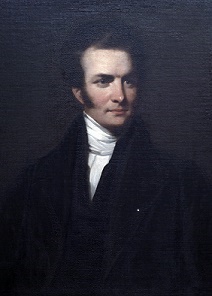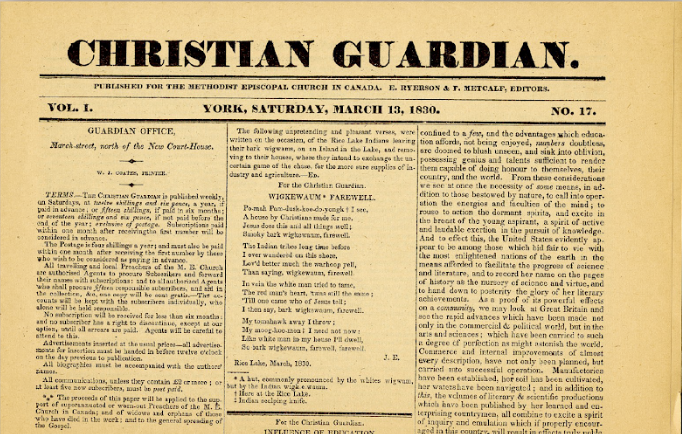Egerton Ryerson (1803-1882) served as founding editor of the Christian Guardian from 1829 to 1832. He returned to the position of editor twice more, holding it again from 1833 to 1835 and from 1838 to 1840. The first issue of the denominational newspaper, published at York (Toronto), appeared on 21 November 1829.
Born 24 March 1803 in Charlotteville Township, Norfolk County, Upper Canada (later Ontario), Egerton Ryerson was part of a United Empire Loyalist family, his father Joseph having served as an officer for the British during the American Revolution. Although baptized Anglican, at age 18 Ryerson formally associated himself with his local Methodist community. In 1827, he was ordained a minister of the Methodist Episcopal Church.

During Ryerson’s initial term as editor, the Christian Guardian — at its outset, a closely printed, four-page weekly — quickly established a readership far beyond Methodist circles. When it commenced, the newspaper had about 450 subscribers, but by 1832 the number stood at approximately 3000.1 According to historian Goldwin French, the Guardian “speedily acquired an influential place in the life of the province” and “sought to inculcate in its constituency a conservative variety of liberalism.”2 Ryerson himself later reflected: “The characteristics of the Christian Guardian during these [first] three eventful years [1829-1832] … were defence of Methodist institutions and character, civil rights, temperance principles, educational progress, and missionary operations.”3 During Ryerson’s first tenure as editor, his editorial stance on issues such as the clergy reserves and education led some to categorize him as a reformer. He challenged the entitled position then enjoyed by the Church of England (i.e., the Anglican Church) in Upper Canada in relation to these matters. For example, he criticized sole control of the clergy reserves by the Anglicans given that these public lands had been designated in 1791 for the maintenance of “Protestant clergy.”4

When Ryerson returned to the editorship of the Christian Guardian for a second time in 1833, his editorial position was more conservative. His second term as editor occurred in the wake of the union between the Methodist Episcopal Church in Canada and the British Wesleyans, and amid the growing political tensions that would eventually result in the Upper Canadian Rebellion of 1837.5 In his efforts to emphasize his church’s loyalty to the British Crown and disassociate it from more radical reform elements, he ended up alienating part of the Methodist community as well as others in Upper Canada. Indeed, one article written by Ryerson inflamed passionate reformer and fellow newspaper editor William Lyon Mackenzie, who proclaimed in his Colonial Advocate that Ryerson had “gone over to the enemy, press, types & all, & hoisted the colours of a cruel, vindictive tory priesthood.”6 Ryerson’s brother William, also a Methodist minister, wrote privately that the Guardian “has been much more popular [in the past] than it is at present.”7 Ryerson departed the editorship in 1835. After his successor took the newspaper too far in a “tory” direction, the church returned Ryerson to the position of editor for a third and final time mid-way through 1838. In his final tenure as editor, Ryerson shifted the Guardian’s editorial position firmly toward the middle ground, his concern to “advance Methodism as a spiritual agency” while using the newspaper as a vehicle for the church “to help solve Upper Canada’s political and social problems.”8
As a publication, the Christian Guardian endured for ninety-six years. During that period, it intermittently expanded in length, and eventually evolved into an illustrated magazine format of more than thirty pages. Methodist unions over the years led it to absorb other denominational newspapers. In 1874, it subsumed the Methodist New Connexion’s Evangelical Witness (est. 1855). Then, at the time of the 1884 union, three more newspapers were amalgamated with the Guardian: the Methodist Episcopal Church in Canada’s Canadian Christian Advocate (est. 1857), the Primitive Methodist Church of Canada’s Christian Journal (est. 1857), and the Bible Christian Church’s The Observer (est. 1866). When the United Church of Canada came into existence in June 1925, the Christian Guardian ceased, and the new church began issuing The New Outlook.
1 Lorne Pierce, ed., The Chronicle of a Century (Toronto: Ryerson Press, [1929]) 13.
2 Goldwin S. French, Parsons & Politics (Toronto: Ryerson Press, 1962) 115.
3 Egerton Ryerson, The Story of My Life, ed. J. George Hodgins (Toronto: William Briggs, 1883) 93.
4 Curtis Fahey, “Clergy Reserves,” Canadian Encyclopedia. https://thecanadianencyclopedia.ca/en/article/clergy-reserves.
5 French 142-44.
6 King quoted in French, 144. The original quote is from the Colonial Advocate of 30 October 1833.
7 William Ryerson cited in French 145.
8 French 173-74. More detail about this period of Ryerson’s editorship can be found in French, chapter 7.






